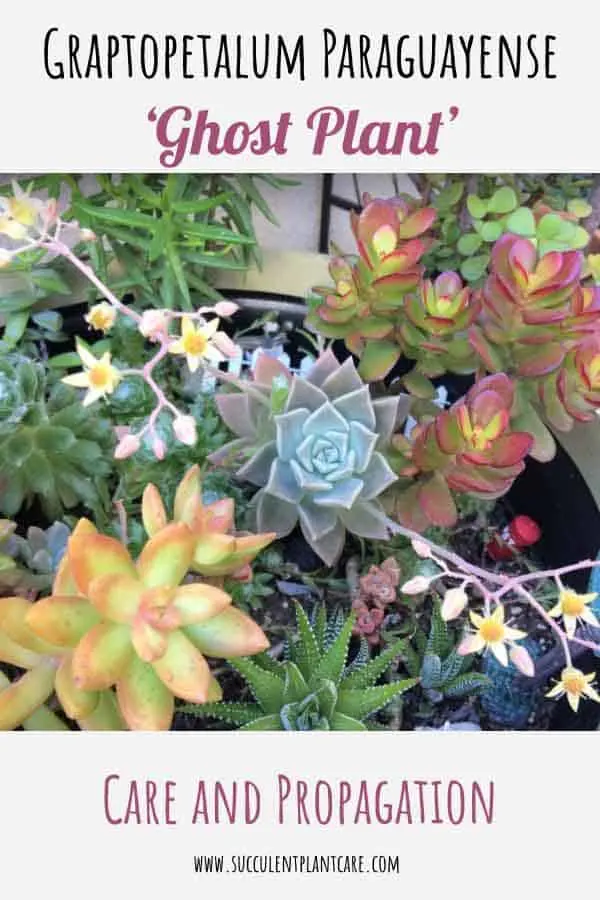Graptopetalum paraguayense, known by their common names ‘Ghost Plant’ and ‘Mother of Pearl Plant’, has powdery blue-green leaves tinged with a mixture of lavender, pink and blue pastels. The stems sprawl out and elongate as they grow and have a tendency to spill out of the container.
Due to its pretty pastel colors, trailing nature and intriguing name, Graptopetalum paraguayense ‘Ghost plant’ continues to be a favorite by many succulent growers. The origin of this plant is quite a mystery as no one knows for sure where it came from. Easy to grow and maintain, it is a popular succulent plant coveted by many. Learn about care, propagation and growing tips here.

Graptopetalum paraguayense ‘Ghost Plant’ Care Guide
Are They Indoor or Outdoor Plants?
Graptopetalum paraguayense ‘Ghost Plant’ can be grown both indoors and out. The most important thing for these plants is to provide them with a well draining potting mix and adequate sunlight. From my experience with these plants, they do really well outside exposed to the natural elements. If you must bring them indoors for the winter, give them some outdoor time during the warmer months and they would surely benefit from it.
Indoor Lighting Requirements
Find the brightest location indoors, or where there is plenty of light. Try an east facing window. South and west facing windows may also work but you may need to move the plant around a few times to find the best spot. If the plant does not receive adequate sunlight, it loses its vibrancy and becomes a dull gray color. It will also start stretching out and elongating if it does not receive adequate light. Move the plant to a brighter location when you see this happening.
To keep these plants really happy, they need approximately 4-6 hours of bright light per day. These plants will not tolerate poor lighting for prolonged periods of time. If your indoor space does not receive adequate lighting no matter where you move the plant, consider using a grow light. Grow lights can help supplement your plants’ lighting requirements especially during those long, dark winters. Here are some of my grow light recommendations.
To read more about this topic on indoor lighting for succulents, check out my post on “Proper Lighting for Succulents Indoors” to get some helpful tips.
Outdoor Sunlight Requirements
Graptopetalum paraguayense ‘Ghost Plant’ do best in areas that receive plenty of bright, partial sunlight. Light Shade to full Sun is best for these plants. They can also tolerate full sun but need to be acclimated to full sun in the beginning to prevent sunburn. They will showcase their best pigmentation of different shades of pale pastels when exposed to more light. The plant has a powdery, waxy coating on its leaves that serves as a protection from the sun. The more intense the sun, the prettier its colors become. Keep them under the shade and the plant will turn a dull gray color.
Before moving the plant outdoors or increasing the amount of sunlight it receives, it is better to acclimate the plant by gradually increasing the amount of sunlight it receives until it is fully acclimated to the more intense sun. Keep in mind that even when the plant is already acclimated to full sun, it can still get sunburned during a heatwave or intense heat.
Sunshades are a real lifesaver for my plants during the intense summer heat here in Northern California where the temperatures can rise above 100℉ or 37.8℃. Here are some of my recommendations for sunshades and sun protection.
For further details and information on outdoor sunlight requirements, please visit my post “How Much Sunlight Do Succulents Need Outdoors?” to get some useful tidbits.
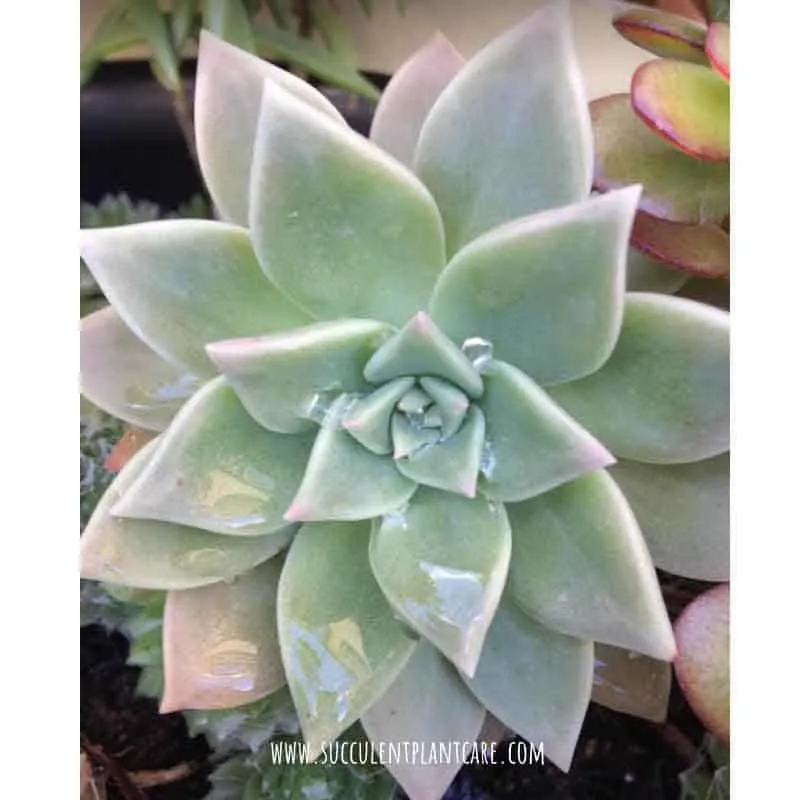
Frost Tolerance
Graptopetalum paraguayense ‘Ghost Plant’ can tolerate mild frost and slightly freezing temperatures. They are cold hardy up to 10-20 ℉ (-6-12 ℃). I have kept mines outdoors all year long, and they survive the freezing rain and frost we experience in the winter time here in Northern California mainly because of all the bright sun we receive during the day. But there are days when I need to protect my plants from a sudden drop in temperature.
For those people in areas with extreme winter conditions, the best way to grow these plants is in containers. That way you can bring them indoors during winter or when there is a forecast of frost or snow. In case you can’t bring your plants in, there are ways to protect them from frost and freezing temperatures outdoors. You can use frost cloths or mini greenhouses to help them survive the cold winter. Here are some of my recommendations for frost protection.
For further tips on this topic, check out my post on “Optimal Temperatures For Succulents to Survive and Thrive”.
Soil Requirements
Like any other succulent plant, Graptopetalum paraguayense ‘Ghost Plant’ do best when planted in a well-draining soil. I have been using a simple and easy mixture that has worked well for my plants. I use a cactus potting mix combined with perlite for added drainage. I do not use exact measurements but eyeball it to about 2:1 solution of cactus mix and perlite (you can use 1:1 cactus mix:perlite solution if you live in a very humid climate). You can also consider making a sandy soil, which adds more drainage to the mix. This can be achieved by mixing cactus mix or potting soil with coarse sand (about 2:1 ratio). Or you can use a combination of the three materials mentioned: Cactus mix, perlite, coarse sand (1:1:1).
I get most of my materials from a local hardware store. You can also purchase them online. Here are my soil recommendations. To read more about soil for succulents, click on “Best Soil and Fertilizer for Succulents” to get more useful information.
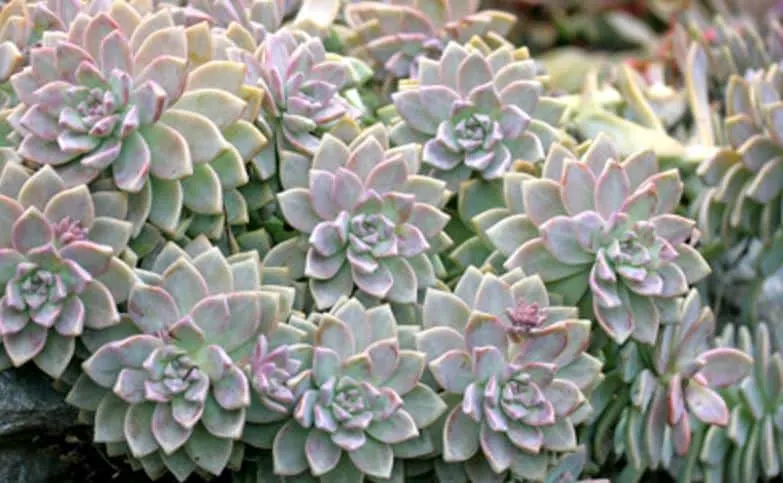
Watering Requirements
Watering largely depends on the climate you live in. Although these plants are highly adapted to dry weather conditions, they thrive when given sufficient amounts of water, but not too much. There really isn’t a set schedule or formula on when to water succulents. My watering schedule is dictated by the very dry climate I live in.
For reference, in the summer months I water my Graptopetalum paraguayense ‘Ghost Plant’ as often as every 7-10 days. I cut back on watering to about every 10-14 days when the weather cools down during spring and fall seasons. During the winter season, I rely mostly on rainwater and hold back on watering altogether because this is when we get a lot of rain in my area. But if we don’t get any rain at all during winter then I water at least once a month or every 2-3 weeks, depending on how dry the soil gets. Keep in mind that I live in a very dry climate and I have most of my succulents outdoors.
For those people in humid locations, you won’t need to water as much. And if you keep your plants indoors, you do not have to water as much especially if they are not receiving a lot of light. Too much water and not enough light is a recipe for disaster for these plants.
One good way to tell whether it’s time to water is to check the moisture of the soil. The top inch of the soil needs to feel dry before you can water again. If you are unsure how much and how often to water in the beginning, it’s always better to underwater and increase watering as needed. Pay attention to how your plant looks and you can adjust watering accordingly.
For further help with watering techniques, consider using tools like hygrometers or moisture meters to check for moisture in the soil and air. These tools are pretty affordable and can come in handy especially if you are unsure of when to water your plant next. I have narrowed down the choices here on my resource page. Do visit the page if you need help in gauging your watering needs.
Interested in finding out more about watering succulents? Visit my post “How And When To Water Succulents” where I go into more details about this topic.
Propagating Graptopetalum paraguayense ‘Ghost Plant’
Graptopetalum paraguayense ‘Ghost Plant’ is not only hardy but also very easy to propagate. The easiest way is through stem cuttings. They also easily propagate from leaf cuttings but leaf cuttings take longer than stem cuttings. I have a much higher success rate with stem cuttings so I always opt for this method first.
How To Propagate Graptopetalum Paraguayense from Stem Cuttings:
- Obtain a stem cutting and let it dry for a day or so. Let the cut ends dry and callous or seal. It is a good idea to obtain cuttings from healthy looking plants with plump leaves, not dehydrated ones or stressed plants.
- (Optional) Dip the cut end in rooting hormone. I usually skip this step but some people prefer using rooting hormones to speed up the process and also guarantee success.
- Once the cut has healed and dried, stick the cuttings in a well-draining potting mix.
- Keep away from direct sunlight. Water the soil every few days or when it feels dry.
After about two weeks or so, you will notice new roots growing.
After about four to six weeks, the cuttings should be fully rooted and you will soon notice new growth developing from the top or the sides of the stem.
Once fully rooted, cut back on the misting and switch to regular watering about once a week or less. Increase the amount of sunlight as the plant matures.
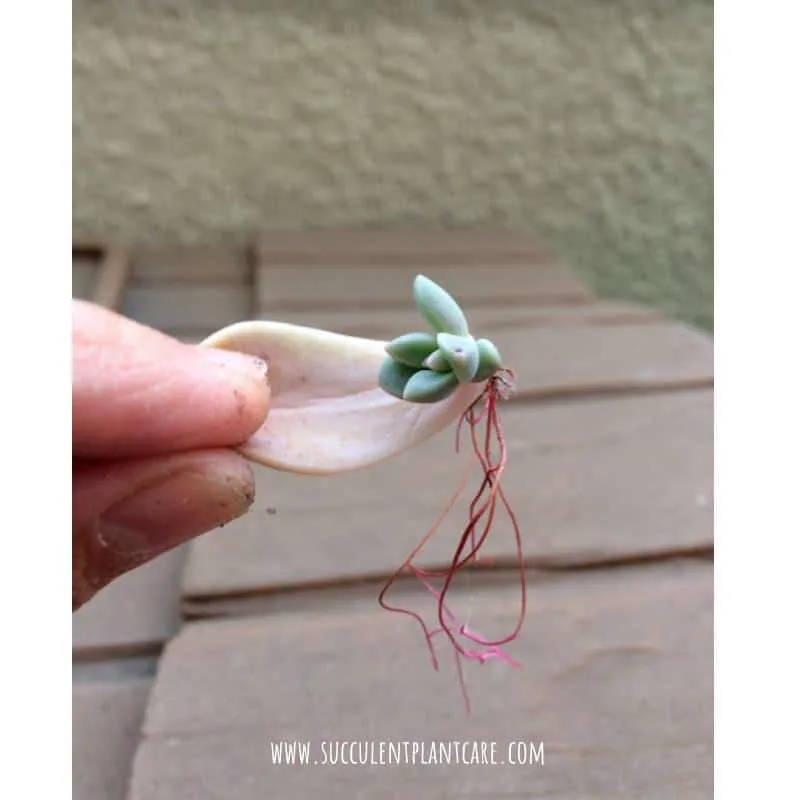
Graptopetalum Paraguayense ‘Ghost Plant’ leaf shooting out roots
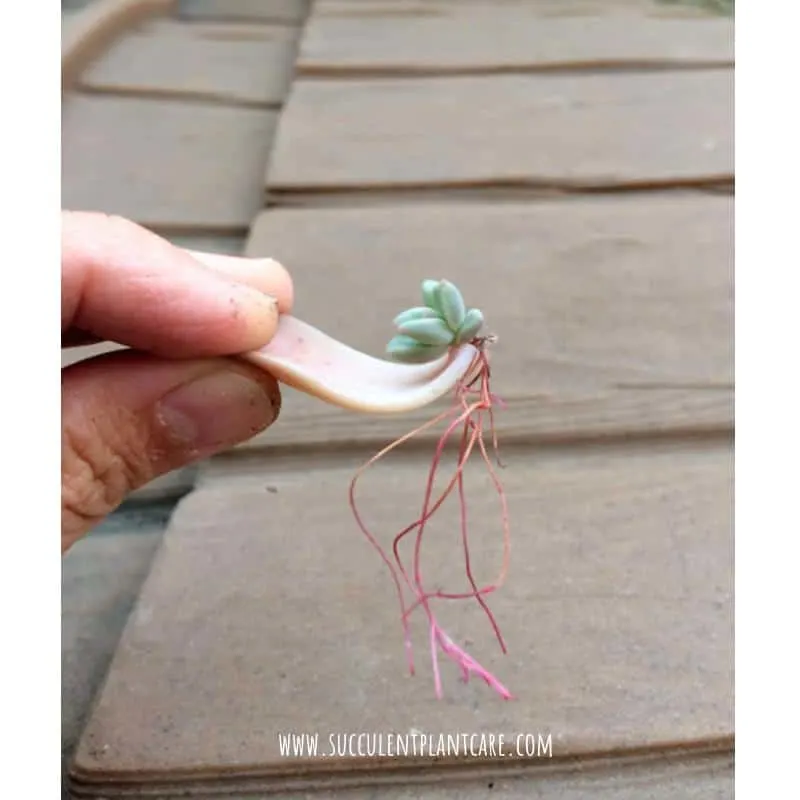
How To Propagate Graptopetalum Paraguayense From Leaves:
- Gently pull a leaf out, make sure you get the entire leaf including the base. You should be able to gently twist the leaf off the plant and it should come off easily. Try to find a nice plump leaf that looks healthy. It also helps to have more than one leaf just because not all of them will make it all the way to the end.
- Optional: Dip the cut ends in rooting hormone. Rooting hormone can help speed the propagation process up, especially when growing from leaves.
- Wait for the leaves to dry for about a day or two. Keep in a dry location away from direct sunlight.
- Prepare a well-draining potting mix. Once dry, lay the leaves flat on the soil or stick the cut ends in soil.
The leaves should start shooting out roots in about 2 weeks or so. In a few more weeks you will notice a new baby plant emerging. The whole process can take anywhere from a few weeks to months.
As I mentioned above, it takes longer to propagate from leaves as opposed to an entire stem. The success rate is also higher with stem cuttings so do keep these in mind when propagating. If you follow these simple steps, you will be able to propagate these plants and have them growing everywhere in no time.
For more on propagating succulents, visit my post “4 Easy Ways to Propagate Succulents: A Step-by-Step Guide“ to learn more.
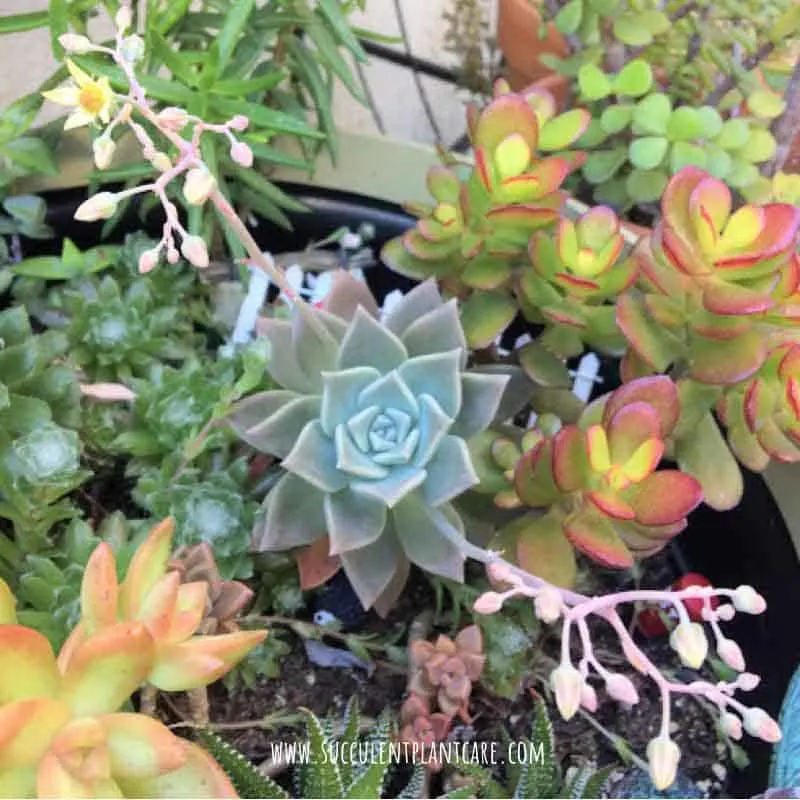
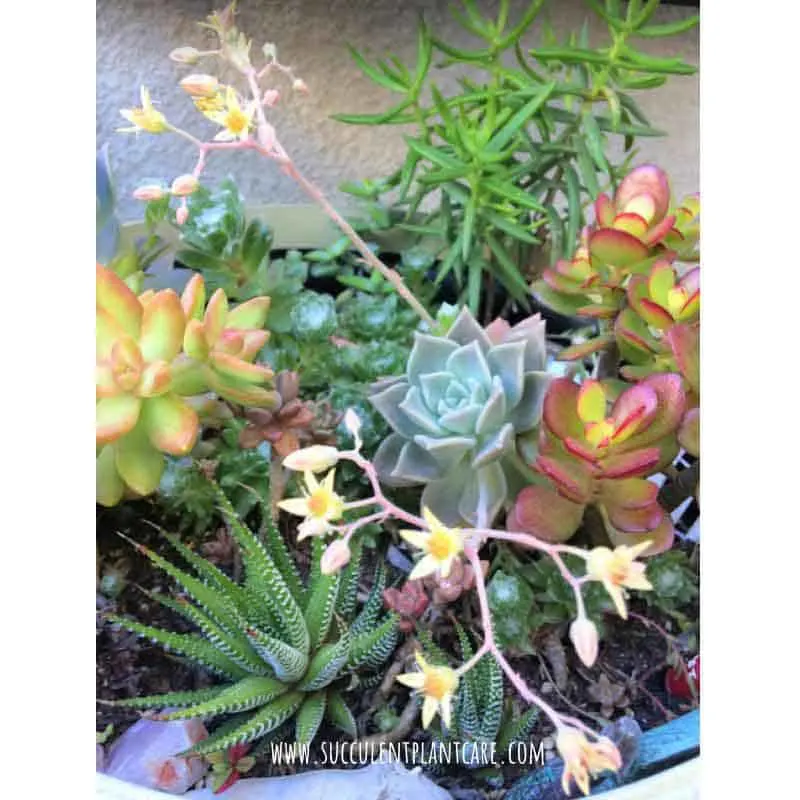
Graptopetalum Paraguayense ‘Ghost Plant’ Blooms
Graptopetalum paraguayense ‘Ghost Plant’ produces white and yellow star-shaped flowers that go very nicely with the pastels. While it’s always a treat to see my succulents bloom, keep in mind that not all plants are ready to flower, and some may not bloom at all. A lot of it depends on environmental factors beyond our control.
Here are some tips on how to encourage a Graptopetalum Paraguayense to bloom:
Plant Maturity
Make sure the plant is mature enough. When a plant blooms it means it is ready to reproduce. If the plant is too young, it is simply not ready to reproduce and therefore will not bloom. Give the plant some time, usually if the plant is over 3 years old and beyond, it is mature enough to bloom.
Plenty of Light
Make sure the plants are receiving adequate sunlight throughout the year and are kept in a bright location, even during colder winter months.
Proper Temperatures
To encourage flowering, provide proper temperatures. They need a distinct difference in night and day temperatures as well as summer and winter months. Succulents favor cooler outdoor nighttime temperatures of 50-55⁰F (10-13⁰C) or indoor night temperatures of at least 60-65⁰F(15-18⁰C). Especially when kept in a controlled environment, succulents prefer a marked difference between their night and day temperatures to mimic their natural habitat, with the cool night temperatures having an integral part in the plant’s growth cycle.
Overwintering
Overwintering is also important if you want to see your succulents bloom. This can be achieved by keeping them cool and relatively dry in the winter months, especially desert cacti. Keep them cool during winter months with temperatures just above freezing, between 35-44⁰F (1.5-7⁰C). If kept indoors during winter, have them in a non-heated room if possible or keep the temperatures low to provide them the cold winter period that they need.
Feed or Fertilize
While fertilizing is not necessary, giving your plants the nutrients they need will help ensure proper growth and encourage blooms. It takes a lot of energy for plants to produce flowers, and feeding them extra nutrients will help supplement their needs during the flowering season. The most common recommendation is to fertilize during the active growing season, or during spring and summer months. Fertilizers are better applied at a quarter or half strength, about every two weeks. Refrain from fertilizing towards the end of the fall season and during winter months. A balanced blend of fertilizer diluted to half strength is suitable and commonly used. Fertilizer blends specially formulated for cacti and succulents are also suitable. Here are some of my fertilizer recommendations.
To read more on succulent blooms, visit my post on “How To Get Succulents and Cacti To Bloom” for more details.
Graptopetalum paraguayense ‘Ghost Plant’ Toxicity to Pets
These are generally considered non-toxic to cats, dogs, or pets. For more information on plant toxicity, visit the ASPCA website for more details. If you suspect poisoning, contact your local veterinarian immediately or the ASPCA Animal Poison Control Center at 888-426-4435.
With a name like ‘Ghost plant’, you can’t help but be intrigued by these beautiful plants. Graptopetalum paraguayense is not only easy, but it is also hardy and propagates easily. It comes as no surprise how popular and well-loved this succulent plant is.
Wondering where you can find Graptopetalum paraguayense ‘Ghost Plant’? Visit my resource page for recommendations on where to find these and other succulent plants online.
Pin this to save for later or share with friends now!

